|
Ancient Ships: The Ships of Antiquity
Ancient Ships in art history: The Ceremonial Uses of Ships in
ancient Egypt and Egyptian art


Relief in a tomb showing Egyptian ceremonial
shrine carried on a river boat Circa 1500 BCE.
During one of the greatest archeological finds in Egyptian History,
in 1922 Howard Carter found similar shrines and boat
models in Tutankhamen’s tomb. The symbols on the side of the Shrine
shown on this relief sculpture are the same as were used in the
Burial shrines of Tutankhamen. This indicates the Iconography was
probably a standard convention used in Egyptian Art and funerary
decorum during this historical time frame ancient Egypt.
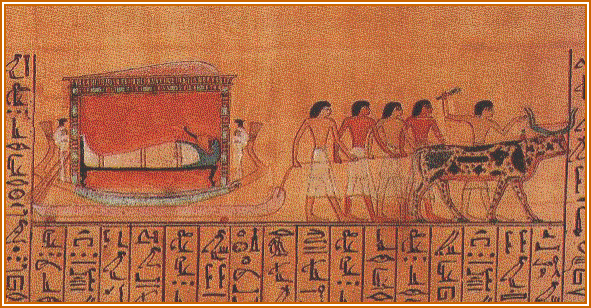
Illustration from the Egyptian Book of the
Dead with funerary shrine and ceremonial ship taking the deceased
to the afterlife. Papyrus credited to the 18th Dynasty 1550
-1307 BCE
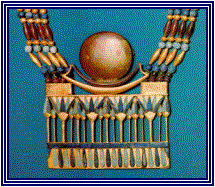 |
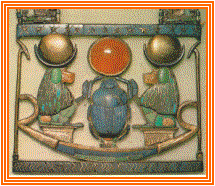 |
Solar Boat
Pectorals from the Tutankhamen Tomb |
Early in Egyptian history the ship was embraced symbolically and
in allegory in union with the cycle of the sun as a natural reflection
of the cycle of life. This concept in their mythology
can be paraphrased "As the sun is the spirit of the day as
a man’s spirit is the light of his life. " In Egyptian
art the sun was shown as carried through the sky on a solar barque,
and mans spirit was shown to travel the afterlife in a spiritual
barque. This remained a theme in funerary art for thousands of years
and was often expressed universally in cultures related to seafaring.

Wall paintings showing ships and boats from
the
tomb of Menna.
Menna was an Egyptian noble who lived in the 18th
Dynasty either during the reign of Tuthmosis IV or that of his successor,
Amenophis III. Akhenaten was Co-regent with Amenophis III
and his successor. This was approximately 1350BCE.
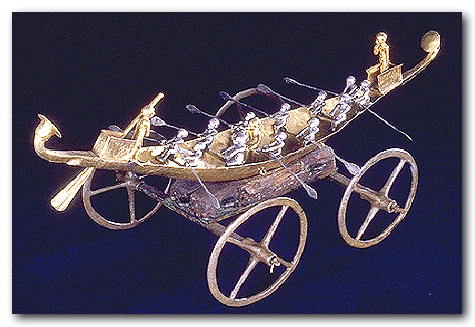
Barque of Ahotep
See Timelines of the Egyptian Pharaohs.

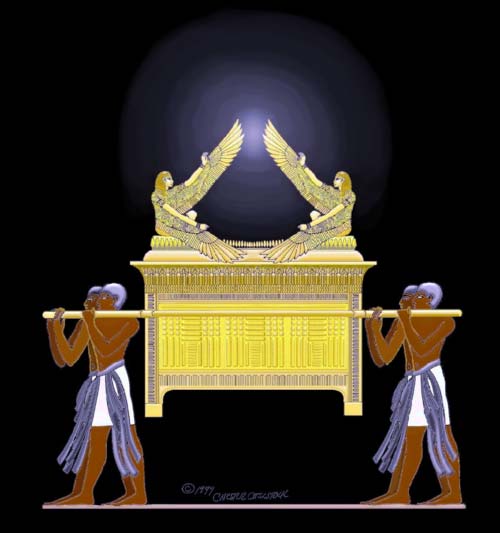
"Ark
of the Covenant”
Was the Ark of the Covenant an archetype of the Egyptian Ceremonial
Funerary Shrines depicted in Egyptian art?
Attempting to put Biblical accounts of the Ark into a larger historical
context has proven to be a tremendous stimulus for research and
comparative analysis. The desire to determine the likely
appearance of the Ark of the Covenant lead me to attempt to determine
the basis for and nature of the major cultural achievements of the
Hebrews from the time of the Exodus from ancient Egypt, circa 1220
BCE, until the Assyrian Captivity of the Hebrews in 586 BCE.
One aspect of the Ark that became evident when examining its scriptural
descriptions was the Ark was itself an archetype of a portable ceremonial
shrine. The basic concept was a desert going transport vehicle
modeled after the portable shrines Egyptians used in ceremony and
ritual. For a more detailed description see the iconography
of the
“Ark Of The Covenant” . It can be argued that the installation
of the Ark of the Covenant to the first temple in Jerusalem was
considered one of the pinnacle events in the history of the Ark
and the coming of age of the Hebrew culture as a political power
in the eastern Mediterranean. The central government responsible
for this achievement was that of Solomon.

One area of interest, which is key to the story of Solomon, was
the fact that he was credited with having employed a large Naval
force. In addition to Solomon’s
Navy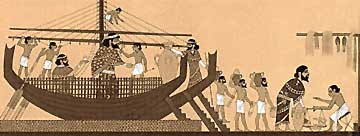 he is credited with being a shrewd diplomat having alliances to
the Sheba, Egypt and Phoenicia
he is credited with being a shrewd diplomat having alliances to
the Sheba, Egypt and Phoenicia
All of theses cultures were known to have had extensive
seafaring capabilities. Sheba alone at this time in
history was credited with having over 400 ships in their fleet of
trading vessels.
Solomon is also credited with having been successful in diplomacy
and trade with the majority of his neighbors. A prime example of
this diplomacy was mentioned in 1
Kings Chapter 5. Which relates his alliance
with the ruler of Tyre, which was the chief seaport of the Phoenicians
at that time. It was these key alliances in trade, diplomacy and
the ability to keep the peace that lead to the apparent success
of his administration. Other trade alliances credited to Solomon
were, Chittim, Ophir and Tarshish. Add to this list of countries
from which Solomon took wives he can truly be said to be an international
figure.
Israel was located at the crossroads of the Levant. The historic
records from Egyptian history and other contemporary cultures before
and leading up to the time of Solomon show this geographic region
to have been a very volatile area and was usually governed as a
vassal state of one of the more prominent powers in the Region.
It is apparent from these records that the region had fallen into
political turmoil after the onset of invasions by the Sea Peoples
against Egypt in 1250 BCE. The early invasions exploits
of Merneptah 1224-1210 BCE against the Sea
Peoples are recorded at Karnak. The later invasions were repulsed
during the rule of Rameses III and recorded at Mendinet Habu in
graphic detail.
Egypt’s influence, political and military dominance was not asserted
again until the Palestinian campaign of Shishak 1 following the
reign of Solomon in 941 BCE. This was the same historic time
frame in which the Hebrews Colonized the Levant according to the
Biblical account. See Timelines
and Events.
The concept that Solomon had and maintained a naval force is key
to understanding the success of his administration. Without understanding
the extent to which sea trade effected the economy of the Eastern
Mediterranean nations it would be difficult to understand much at
all about the diplomacy of this historic time frame.
One of the most interesting stories that suggests the extent
of travel and trade that occurred in the prehistoric era is the
Milesian Myth
of the Irish. This myth is considered to be legend and falls outside
of the classification of history but the story line intimates the
extent to which travel, trade and colonization may have occurred
in the ancient world. One account of this story attributes
Milesius to be the brother in law of Solomon. This would be the
case if both were married to the daughters of the same Egyptian
Pharaoh, considering each had Egyptian wives.
By this account travel and trade occurred between the British Isles,
the Spanish Coast, the Mediterranean Island Nations, the Northern
Black Sea, and the eastern Mediterranean coasts to Egypt as early
as 1700BCE. The Irish Milesians are not to be confused with
the Miletian Greeks from Lydia. It is tempting to indulge in conjecture
that although we do no have a reliable written record to verify
this extensive travel did indeed occur.
Navigation was accomplished not in the open ocean but primarily
by short hops along and within view of coastlines. For merchant
ships powered by sail a daily sailing effort would have covered
fro 50 to 75 miles under good conditions. Travel and extended trade
may have been more prevalent than conservative estimates suggest.
The best archeology confirming the extent of travel and trading
patterns are the Uluburun
Bronze Age Shipwreck and shipwreck at Cape Gelidonya on
the Turkish coast. Both cargos contain Egyptian art which suggests
trading patterns that covered a wide territory including the Aegean
Island Nations, parts of Africa and the Middle East.
Written records verify trading patterns of the Egyptians included
travel through the Red Sea to sub-Saharan Africa as far a Somalia,
along the western coast as early 2450BCE. The fact that trade was
conducted south makes it easy to speculate that similar length journeys
would have been made into Mediterranean basin. The most adventuresome
of estimates suggest that the Negroid features found on sculptures
in Messo-America are due to the fact Africans did indeed arrive
by sea in the western hemisphere as early as 1700BCE.
Considering the fact that the history of the Levant indicates
that it was generally void of strong civil government from the time
of the Exodus until the time of Solomon, the ability of his administration
to maintain the peace, conduct adequate diplomacy for trade and
to guarantee the safety of his kingdom was nothing less than a formidable
task. Solomon according to Biblical accounts had strong diplomatic
and trading relationships with Hiram the ruler of the city state
of Tyre in Phoenicia, the foremost seafaring nation in the Eastern
Mediterranean. These relationships were beneficial to Israel to
the extent that this foreign king assisted Solomon in the creation
of a naval force. This piqued my curiosity as to the likely appearance
and structure of the naval
forces of Solomon and to find out what seafaring technologies
were available at the time to put a naval force to sea.
This file is an overview of the iconography of ships, naval technologies
and developments in antiquity leading up to and encompassing the
time of Solomon Circa 1000BCE. The ships and boating illustrated
here are my findings from the Internet. This material will
be incorporated into a larger work called ”Discovering the Historic
Solomon” which will highlight the various crafts and technologies
in the Eastern Mediterranean region, where they were developed and
how they may have been applied in the Levant by the early Hebrew
Culture. These files constitute an overview of the Iconography of
the ship from the earliest recorded history and a display of the
modern models and illustrations of ancient ships.
As a result of creating this file I have concluded that probably
no other technology in the history of man has been more important
to the spread of civilization, culture and trade in the world than
that of the ship.
Table Of Contents
Previous
Next

|
